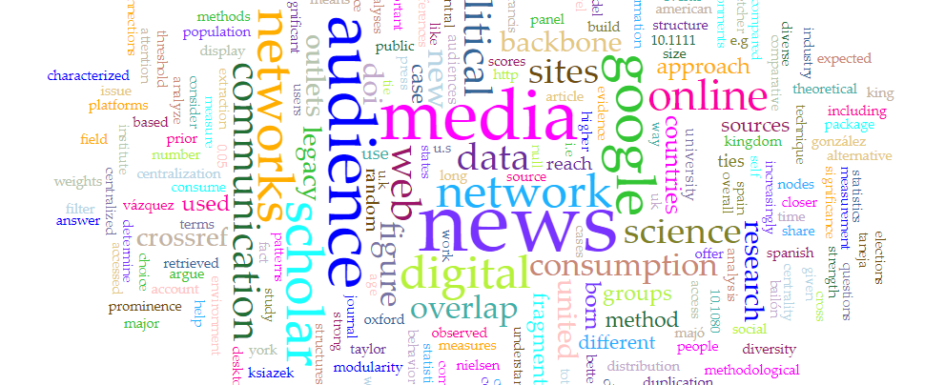
Sandra González-Bailón began her presentation to the faculty and student participants of the University of Pittsburgh’s Information Ecosystems Sawyer Seminar on Friday, Dec. 6, by discussing one of the first sociology classes she took as an undergraduate in the late 1990s. She recalled learning about the debate between two early sociologists, Gabriel Tarde and Émile Durkheim, who disagreed about what role individuals played in social institutions and social interactions.
Tarde suspected that social changes or developments occurred when people with social influence adopted the change or development. He argued this influence might not happen in physical space, but rather occurred between individuals writing letters to one another, or speaking to each other on a new invention, the telephone.
Durkheim, on the other hand, argued that societies exist as amalgamations of the people who comprise them. This society is a new entity that is greater than any one group of people or small cabal of influencers. Durkheim was less interested in individual interpersonal interactions that was Tarde.
Durkheim was able to back up his claims with data, and as González-Bailón put it, “won” the debate. He is considered to be a father of modern sociology.
But González-Bailón, who teaches at the University of Pennsylvania’s Annenberg School of Communication and the Warren Center for Network and Data Sciences and studies the way social networks form and function online, suspects that, if Tarde had lived today and had the kind of data that social media or email can yield, he would have been able to better support some of his suppositions.
The segue into the history of sociology was a reminder of the importance of data, and the right kind of data, in answering questions. Milgram’s experiment can now be replicated using email or social media networks. Tarde’s intuition that he was unable to test fully is now coming into prominence again, a century later.
More directly connected to González-Bailón’s own work is that of social psychologist Stanley Milgram, who showed the interconnectedness of individuals in large societies with his 1967 “small world experiment,” in which individuals received packages in the mail and were asked to try to get the packages to another individual they did not know, simply by forwarding the package to someone else they knew who they thought might know someone who could help ferry it along. Milgram came up with the now-famous “six degrees of separation” hypothesis because of the experiment, which demonstrated in real-world ways the social networks that hold us together.
Recently, González-Bailón has applied her own interest in network theory and the Internet to the study of the ways that people consume news online and whether or not they form fragmented news bubbles. In a December 2018 article published in the journal Political Communication by González-Bailón and her colleagues, Sílvia Majó-Vázquez and Rasmus K. Nielsen, these researchers used trace data provided by media analytics company Comscore (in which participants’ online activities were tracked voluntarily) to locate audience networks in the United States, United Kingdom, and Spain. Using a computational method called backbone extraction that identifies statistically significant ties between shared media outlets, they argued that they could offer a clearer view of which sources are shared among news consumers. By locating these backbones, which are “the most significant overlap…in networks of news consumption,” they were able to find the most significant ties between individual media sites. Extracting backbones in this way helped them determine whether or not news consumers’ networks of media consumption overlapped.
They found that in Spain and the U.K., legacy media outlets – those that pre-date the Internet – still dominated news consumption. In the United States, digital-born media outlets had a slight edge over legacy media. However, their analysis showed that the stereotypical news bubbles and fragmentation do not seem to exist. “Online news consumption patterns are, rather, characterized by strong convergence around a few major outlets,” they write. Online news consumers, then, do not seem to be visiting a small handful of sites, with those of certain political affiliations visiting one group and those of another political affiliation visiting another group. Rather, there is heavy overlap among news consumers. These results may very well have interested Gabriel Tarde, with their gesturing toward the strong but difficult-to-track networks of information gathering that news consumers engage in.
While these findings are fascinating for people interested in politics and news consumption, they, like all data, cannot tell the whole story. When I interviewed González-Bailón for an upcoming episode of the Information Ecosystems podcast, she noted that a minority of Americans actually consume their news online, their data does not take into account news consumption via social media sites such as Facebook, and their findings do not explain why people consume news the way they do. These are issues for another day and for a different data set.
The data available in the Internet age has allowed sociologists such as González-Bailón and her colleagues to ask questions and find networks that past sociologists such as Gabriel Tarde could have only imagined. Ironically, the data that is used to study online behavior is only available because the Internet’s infrastructure allows for the collection of large amounts of data about users’ behavior.
Briana Wipf is a PhD student in the English Department at the University of Pittsburgh. A former journalist, she encourages everyone who reads this blog to subscribe to their local newspaper. Follow her on Twitter @Briana_Wipf.
